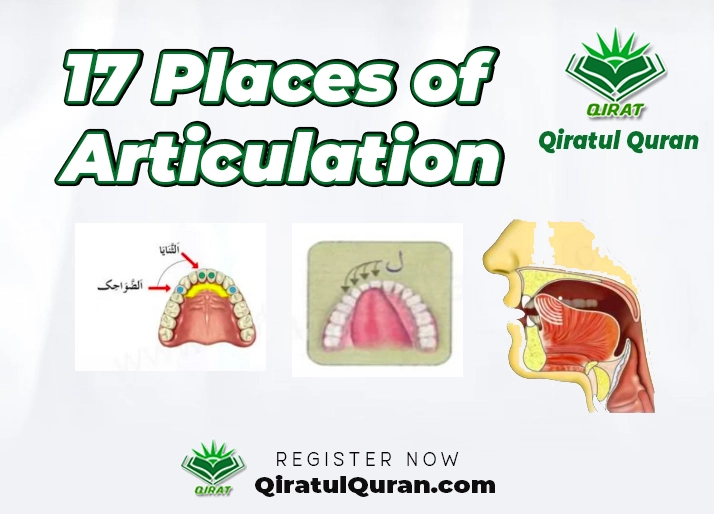
What are the 17 Makharijs?
17 Places of Articulation, The 17 Makharij (Arabic: مخارج, singular: Makhraj) refer to the 17 articulation points in the vocal tract where Arabic letters are produced. They are:
The Throat
- Al-Halq (الحلق) – the inner throat
The Tongue
- Al-Lisan (اللسان) – the tongue
The Two Lips
- Ash-Shafatān (الشفتان) – the two lips
The Nasal Passages
- Al-Khayshum (الخيشوم) – the nasal passages
The Teeth
- Al-Athnān (الأسنان) – the teeth
The Alveolar Ridge
- Lathat al-alsan (لثة الأسنان) – the alveolar ridge
The Hard Palate
- Al-Jauf (الجوف) – the hard palate
The Soft Palate
- An-Naha (الناحية) – the soft palate
The Uvula
- Al-Luateh (اللهاة) – the uvula
The Glottis
- Al-Hanjar (الهنجرة ) – the glottis
So in summary, the 17 places of articulation are:
- Throat
- Tongue
- Two lips
- Nasal passages
- Teeth
- Alveolar ridge
- Hard palate
- Soft palate
- Uvula
- Glottis
What is Makhraj Al Huruf?
Makhraj Al Huruf (مخرج الحروف) refers to the articulation point or place of articulation of Arabic letters. It is the specific point in the vocal tract where the letter is produced.
Each Arabic letter has its distinct makhraj. Identifying the exact Makhraj is important for proper tajweed and pronunciation of the Quranic recitation (Maqamat).
There are 17 places of articulation or makharij that letters can originate from. These include locations like the tip of the tongue, throat, lips, and nasal passage. Knowing the Makhraj helps one pronounce letters correctly.
How many articulation points are there in Tajweed?
There are 17 articulation points (Makharij) in Tajweed. These 17 Places of Articulation cover the entire vocal tract from the throat to the lips where letter sounds originate.
Some of the key articulation points in Tajweed include:
- The throat (al-Halq)
- The tongue (al-lisan)
- The two lips (ash-Shafatayn)
- The nasal passage (al-Khayshum)
- The teeth (al-Athnan)
- The alveolar ridge (lathaat al-alsan)
- The hard palate (al-Jauf)
- The soft palate (an-Naha)
- The uvula (al-luateh)
- The glottis (al-hanjar)
Mastering the specifics of the 17 Makharij is essential for proper pronunciation (Talaffuz) of the Arabic alphabet letters while reciting the Quran. Tajweed rules cover everything from the characteristics of letters (sifaat Al-Huruuf) to how they should be articulated point by point.
What are the 5 main Makharij?
The 5 main Makharij (articulation points) in tajweed are:
- Al-Jauf (الجوف) – The hard palate. Letters like ق ء خ غ originate from here.
- Al-Halq (الحلق) – The inner throat. Letters like ء ه ع ح originate from here.
- Al-Lisan (اللسان) – The tongue. Letters like ر ل ن ط ظ ض ص س ز ش originate from here.
- Ash-Shafatayn (الشفتان) – The two lips. Letters like م ب ف و originate from here.
- Al-Khayshoom (الخيشوم) – The nasal passage. Letters like م ن originate from here as well.
These 5 broad makharij further branch into more precise points for each Arabic letter. But learning the general origination points is an important first step.
What are the 18 letters of the tongue in Tajweed?
The 18 letters of the tongue (huruf al-lisan) in Tajweed are:
ص، س، ز، ش، ض، ظ، ل، ر، ن، ط، د، ت، ظ، ث، ذ، ج، ي، ل
These letters all have their articulation point on some part of the tongue. They can further be categorized based on which part of the tongue they originate from:
Tip of the Tongue – ل، ر، ن
Middle of the Tongue – ط، د، ت، ظ
Base of the Tongue – ص، س، ز، ش، ض، ظ
Sides of the Tongue – ث، ذ، ج، ي
Memorizing these letters and their classifications helps in perfecting tajweed and applying rules specific to them. For example, letters from the tip of the tongue have the Sifa (quality) of Itbaaq while middle tongue letters have Istilaam (concavity).
What is makharij and sifaat?
Makharij (مخارِج) refers to the articulation points of letters in the vocal tract. Sifaat (صفات) refers to the attributes or characteristics of those letters.
Together, Makharij and Sifaat make up two integral aspects of tajweed. Makharij focuses on where Arabic letters are pronounced from. Sifaat focuses on how they are pronounced in terms of various vocal qualities.
Some key examples of Makharij and Sifaat:
Makharij – Letters like ح ha originate from the inner throat (al-halq). Letters like ف fa originate from the two lips (ash-shafatayn).
Sifaat – Letters like ص saad have the attribute (sifa) of istifaal or whistling. Letters like ر Raa have the quality of Itbaaq where the tip of the tongue is inverted.
So in essence, Makharij is about the letter origination points and Sifaat describes letter characteristics. Tajweed’s mastery requires expertise in both disciplines simultaneously.
How many letters are in Hijaiyah?
There are 29 letters in the Arabic Hijaiyyah alphabet (الحُرُوف العَرَبِيّة). The 29 Arabic letters, also called Hurooful Hijaaiya, are:
أ ب ت ث ج ح خ د ذ ر ز س ش ص ض ط ظ ع غ ف ق ك ل م ن و ي
These 29 letters combined create all the words of the Arabic language. Each letter has a fixed sound and form.
In terms of numbers:
- 2 letters are unique to Arabic: ث, ذ.
- 6 letters cannot connect to the following letter: ا د ذ ر ز و.
- The rest of the 21 letters can connect.
This alphabet of 29 letters, developed in the 6th century CE, is used by over 300 million people around the world every day to write and read Arabic.
What are Tafkheem and Tarqeeq?
Tafkheem and Tarqeeq are two key concepts in the proper enunciation (Tilaawah) of Arabic letters while reciting the Holy Quran.
Tafkheem refers to making a letter sound heavier and emphasized. For example, the qaaf ق letter is always pronounced with Tafkheem, meaning the heavy, deep sound from the throat is accentuated.
Some examples of letters with the Sifa of Tafkheem include:
- The qaaf letter (ق) is always pronounced from the throat.
- The Daad letter (ض) – When appearing with a Sukoon ْ.
- The ta letter (ت) – When appearing with two dhammah.
On the other hand, Tarqeeq refers to making a letter sound lighter and softened. The taa Marbuutah ة when appearing in the middle or end of words is always recited with tarqeeq, meaning the letters that have the tarqeeq sifa are articulated lightly from their makharij.
Some examples of Tarqeq Sifa include:
- The Raa letter (ر) – When appearing with a Fathah.
- The jeem letter (ج) – When appearing with a kasrah.
- The taa Marboutah (ة) – At the end of words when stopping on it.
What is Sifat Al Huroof?
Sifat Al Huroof (صفة الحروف) refers to the different attributes and characteristics of Arabic letters. These qualities are an essential aspect of proper tajweed and Makharij.
Some examples of Sifat al Huroof are:
Itbaaq – Inversion of the base of the tongue. Letters like ر Raa have this quality.
Istifaal – Whistling sound from narrowing tongue airflow. Letters like ص, ز, س saad have this quality.
Qalqalah – Bouncing of sound by vibrating tongue. Letters like د, ت, ب have this when carrying Sukoon.
Istitaalah – Spreading around the sides of the tongue. Seen in letters like ق and ك.
There are over 14 essential qualities Arabic sounds can have. Developing expertise in these attributes allows perfect enunciation required in Quranic recitations.
What is the difference between Hams and Jahr?
Hams and Jahr refer to two different methods/levels of articulating Arabic letters while reciting the Holy Quran (Tilaawah).
Jahr: Pronouncing letter sounds clearly and distinctly, not concealed in any way. For example, pronouncing Noon س and Meem م with complete clarity and lip movement. Jahr is the default and most common method of reciting.
Hams: Articulating letter sounds from their Makharij while concealing and subduing them partially. Almost like a whisper. Very few letters like ك – prolongation are recited with hams based on complex tajweed rules. It requires great mastery.
The two methods strikingly affect how words are pronounced:
Jahr Recitation: وَأُوتُوا ٱلْكِتَٰبَ
Hams Recitation (letters highlighted): وَأُوتُوا لْكِتَٰبَ
As seen above, the rules for hams and jahr applications are complex for non-native reciters. But they allow the Quran to be recited both loudly and softly depending on need and situation.






Pingback: How Do You Get a Good Quran Recitation Voice - Qiratul Quran
Pingback: What is the meaning of Hifz in Islam - Qiratul Quran
Pingback: Quran Memorization in Murattal (Slowed & Tarteel) Style
Pingback: How to Train Your Voice for Quran Recitation at Qiratul Quran
Pingback: Perfect Your Voice in Quran Recitation - Qiratul Quran
Pingback: Best Online Hifz Program at Qiratul Quran Institute
Pingback: Tajweed Rules for Kids (Children) at Qiratul Quran Institute
Pingback: Best Quran Classes for Toddlers | 3, 4 to 6 Years old Children